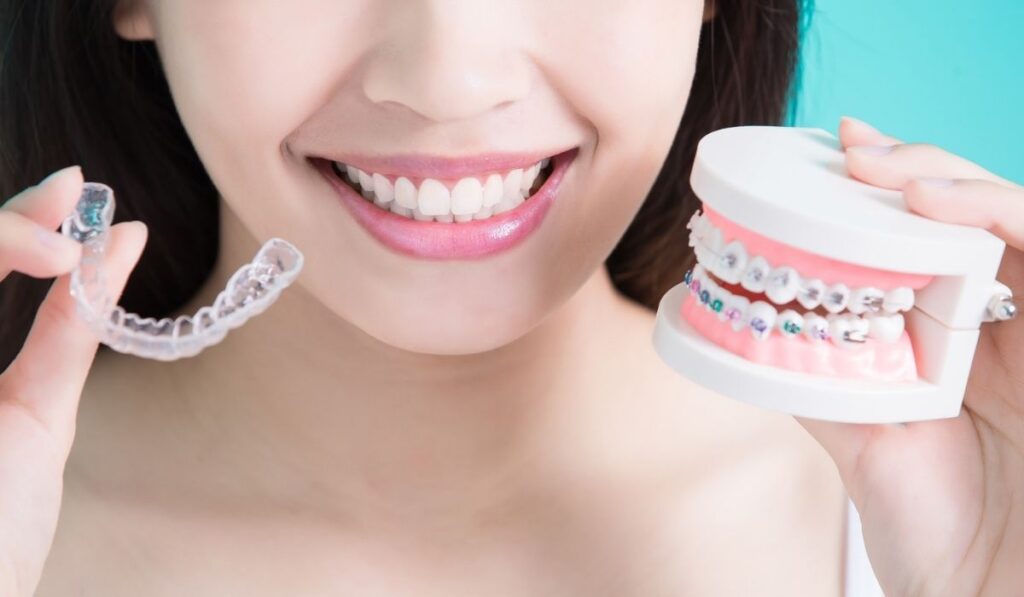Jaw misalignment is a serious problem that can impact a person’s self-confidence and affect their oral health. Luckily, there are a lot of treatment options for jaw misalignment. Depending upon the severity of the case, the treatment may be surgical or non-surgical, like braces.
Jaw misalignment can, in many cases, be fixed using braces. Clear aligners are usually sufficient for typical cases of misalignment, while more severe cases may require the use of self-ligating or headgear braces. Fixing the problem may take 8-24 months.
Surgical treatments are also available for jaw misalignment. Your orthodontist will be able to guide you through the options, but first, let’s review the causes and symptoms of jaw misalignment so that you can identify it and get it treated right away.
What Is Jaw Misalignment?

Misalignment between the maxilla (upper jaw) and mandible (lower jaw) is called a jaw misalignment. In this case, the upper and lower teeth are unable to meet properly when your mouth rests.
An uneven jaw can disturb simple daily tasks such as chewing, talking, brushing teeth, sleeping, etc. It can be congenital or caused by diseases and dental traumas.
Causes of Jaw Misalignment
Some of the causes of a misaligned jaw include:
Genetics
Some people are born with deformities in their jaws. The misalignment can be on one or both sides of the face. It disturbs the symmetry of the face. It can also be due to a cleft palate (harelip).
TMJ Disorder (TMD)
The temporomandibular joint disorder (TMD) is a common jaw misalignment cause. It can occur due to issues in the joint or the surrounding ligaments. Some symptoms of TMD include tooth and jaw pain, headache, inflammation, etc. Arthritis and dental trauma can be causes of TMD.
TMD is usually not corrected with braces alone. Surgery by a TMD specialist may be necessary.
Bruxism
Clenching and grinding of the teeth can contribute to misalignment by causing high force and stress on the joints and muscles of the jaw, thereby wearing away the connective tissues lining. Treating bruxism and wearing a dental guard at night can prevent a misaligned jaw due to bruxism.
Injury
Falling or sports injuries can cause a misaligned jaw if it is affected directly. A fracture in the mandible or maxilla can disturb the alignment of the jaw.
Malocclusion
Malocclusion comes in different types such as overbite and underbite. All malocclusion types can disturb the jaw alignment, thereby causing a crooked jaw. It can be due to inheritance, teeth crowding, pacifier use or thumb sucking, etc.
Symptoms of Jaw Misalignment
It is important to know the symptoms of jaw misalignment so that you can get timely treatment. Look out for these symptoms:
- Pain while eating or talking
- Inability to move your jaw in a normal manner
- Pain in the temple, jaw joint, and surrounding areas
- Breathing through the mouth
- Shoulder or back pain
- Clicking sound in the jaw
- Abnormal drooling
How Can You Fix a Misaligned Jaw?
Fixing a misaligned jaw depends upon the severity of the misalignment. Your dentist can suggest the best treatment by checking the condition of your jaw. Some patients with jaw misalignment might even require surgery. Here are some possible treatment options:
Palate Expander
A palate expander (also called an upper jaw expander) corrects width problems in the upper jaw. It widens the upper jaw so that it can align correctly with the lower jaw. Correcting a misaligned jaw using a palate expander also helps with bite issues such as crossbite. It allows more space for your teeth to align better.
This treatment is suitable for early adolescent years when the maxillary bones haven’t fused properly. A palate expander works by expanding the maxillary bones. It can stay in your mouth anywhere from 6 months to one year, depending upon your case of jaw misalignment.
Even when the bones have been widened, the palate expander stays there for some time. This is to prevent the maxillary bones from compressing again. Removing the expander too early can cause a reversal of the widening process.
Orthognathic Surgery
Orthognathic surgery (also called corrective jaw surgery) is a group of surgeries that are used for jaw misalignment. They can be done on the upper jaw or lower jaw, depending upon your condition.
The surgeries involve movement of jaw bones and teeth to have a better alignment, cure bite problems, and provide an aesthetically pleasing smile and facial appearance. Some famous orthognathic surgeries are mentioned below.
Maxillomandibular Fixation (Jaw Wiring)
In case of a trauma or broken jaw, jaw wiring can be done. In this process, a metal wire or elastic band is used to bind the bones of the upper and lower jaw. The process is complicated and you have to take a liquid diet while you have jaw wiring.
It cures jaw misalignment and bites problems including crossbite, underbite, and overbite. It can take about six weeks to heal your bones and involves some risks too.
Jaw wiring is a surgical process done after using anesthesia.
Maxillary and Mandibular Osteotomy
Osteotomy is the cutting and reshaping of bones. It can be used to correct a misaligned jaw by cutting and reshaping maxillary and mandibular bones. It can correct crossbite, underbite, and a protruding lower jaw.
The process is done by moving either the upper jaw forward or the lower jaw forward or backward. The teeth are also moved depending upon the condition of the misalignment.
Do Braces Reposition Your Jaw?

Wearing braces can fix jaw misalignment if the problem isn’t severe and doesn’t require surgery. If the jaw misalignment is due to crooked or misaligned teeth, braces are suitable for the treatment. There are multiple types of braces that you can get for jaw misalignment. Let’s look at the different types.
Clear Aligners
Both clear aligners and metal braces are suitable for jaw misalignment. In the past, traditional metal braces were the only option, but they made many people feel self-conscious. Nowadays, clear aligners have changed the game.
They aren’t very noticeable, and you can remove them while eating or brushing your teeth.
Braces
Braces made of ceramic or metal aren’t removable. They put a lot of pressure on your teeth causing them to shift, which can help with your jaw misalignment.
Self-ligating braces are best as they don’t require regular adjustments. However, your dentist can suggest the best types of braces for you.
Headgear Braces
Headgear braces treat more severe types of bite issues and jaw misalignment. Headgear can help guide jaw alignment in children. It’s a device that partially stays out of your mouth and is attached to the head.
You have to wear headgear braces for 12-14 hours daily. Usually, patients keep it on for 8 hours while sleeping and complete the remaining hours while they’re awake. It works by applying a constant force on the upper or lower jaw.


